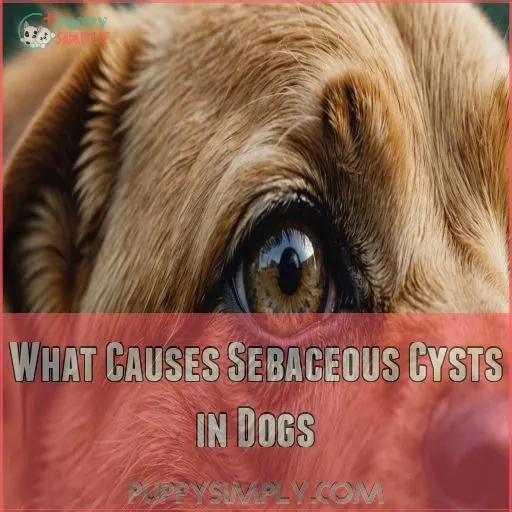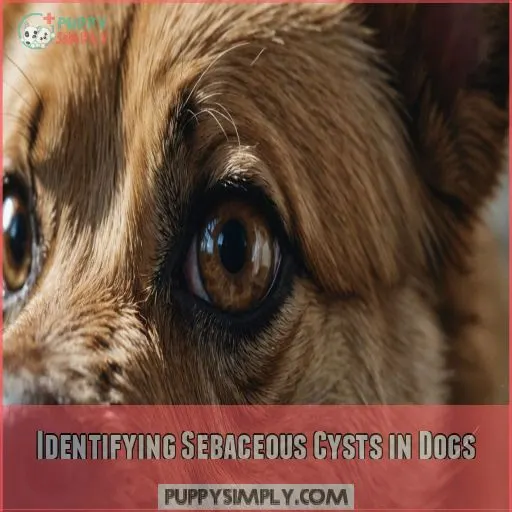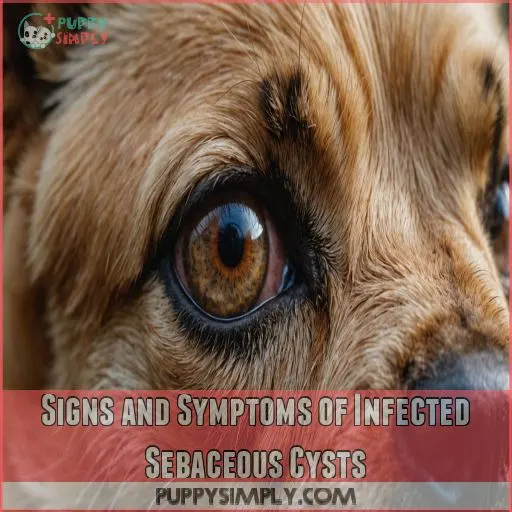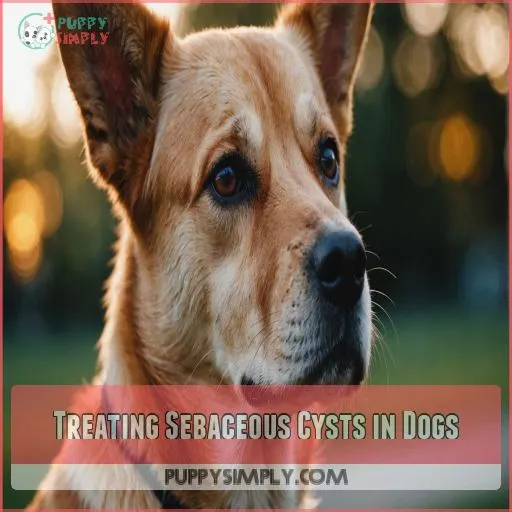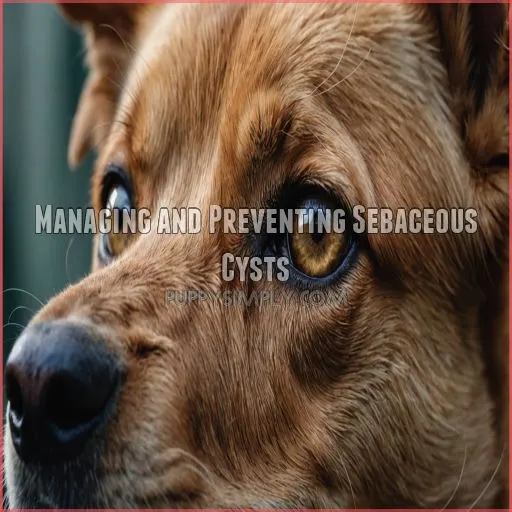This site is supported by our readers. We may earn a commission, at no cost to you, if you purchase through links.
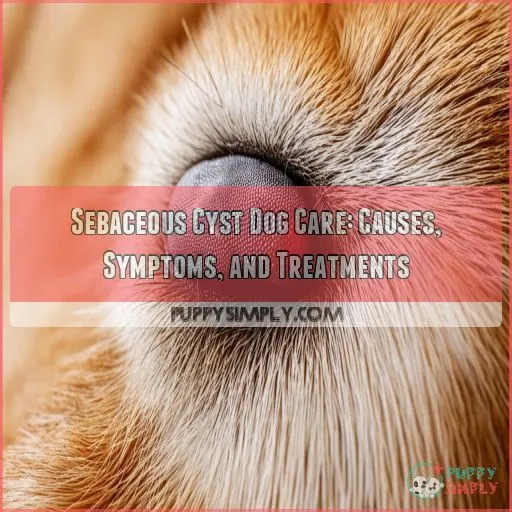 Sebaceous cysts in dogs are like the uninvited guest at a party—they seem harmless until they start causing trouble.
Sebaceous cysts in dogs are like the uninvited guest at a party—they seem harmless until they start causing trouble.
These benign bumps form when sebaceous glands get blocked, often due to genetics, skin irritation, or gland blockages.
While typically harmless, they can cause discomfort if they become inflamed or infected.
Keeping your dog’s skin healthy with regular grooming and a balanced diet can help keep cysts at bay.
If you notice these lumps, a quick trip to the vet can make sure the right care plan is in place.
Want to keep those pesky bumps away? Stick around to discover some handy tips.
Table Of Contents
Key Takeaways
- You’ll notice sebaceous cysts as small, round lumps on your dog’s skin, often due to blocked sebaceous glands.
- Keep your dog’s skin healthy with regular grooming and a balanced diet to help prevent the cysts.
- Watch for signs of infection in cysts, like redness, swelling, and smelly discharge, and consult a vet if these occur.
- Surgical removal is an option for cysts, but for dog ear infections, there are also natural remedies for dog ear infections, such as green tea rinses and calendula tinctures, which can be used as a starting point for exploring non-surgical remedies like antiseptic creams and home treatments can also help manage them.
What Causes Sebaceous Cysts in Dogs
You’re probably wondering why your dog has developed a sebaceous cyst, and the causes can be as varied as your dog’s tastes in snacks.
These cysts may arise from genetic factors, skin irritation, gland blockages, hormonal changes, or even something as simple as diet and environmental influences.
Genetics and Heredity
Your furry friend’s sebaceous cysts might’ve a genetic twist!
Breed predisposition plays a role, with some dogs like Boxers and Shih Tzus having a genetic tick.
Genetic testing helps spot inheritance patterns and gene mutations.
It’s like canine ancestry.com but without the family drama!
Understanding these factors keeps you one paw ahead.
Skin Irritation and Allergies
After exploring genetic factors, it’s time to think about skin irritation and allergies.
Common allergens, seasonal allergies, and food sensitivities can cause sebaceous cysts by leading to frequent inflammation.
Dogs can get pimples due to various factors, including hormonal changes. Treating hotspots with appropriate skin care tips can help manage these issues.
Make sure your dog’s environment and diet support healthy skin, reducing the chances of cysts developing.
Gland Blockages and Infections
Dogs with sebaceous cysts might be dealing with a pesky blocked gland.
Debris or foreign objects clogging the sebaceous glands often lead to cysts, and the risk of infection looms if these swellings burst unexpectedly.
To prevent this, keep those furry friends clean, consider antibiotic therapy, and explore home remedies.
You’re in control, protecting against gland blockage causes and cyst rupture risks.
Hormonal Imbalances and Age
For aging dogs, hormonal changes can lead to sebaceous cysts. Understanding these changes helps in managing the risk.
Here’s what to watch for: Increased sebaceous gland activity due to age. Breed predispositions can play a role. Changes in coat texture may signal issues.
Regular dental care is essential in preventing issues like periodontal disease, as discussed in dog dental care, and always remember, senior dog care involves monitoring health shifts and consulting your vet regularly.
Environmental Factors and Diet
Your dog’s diet and environment can contribute to sebaceous cysts.
Avoid feeding table scraps and provide a balanced, high-quality diet with supplements if needed.
Keep your pup’s living space clean and dry, and steer clear of areas with lots of gravel, sand, or debris that could irritate their skin.
Reducing stress through proper grooming and exercise also helps prevent these pesky cysts.
Identifying Sebaceous Cysts in Dogs
Spotting sebaceous cysts on your furry friend can be straightforward if you know what to look for, like small, round lumps under their coat.
You’ll often find these harmless bumps on a dog’s back, neck, or tail, making regular grooming sessions an excellent time for a cyst check-up.
Typical Locations and Appearances
After understanding what causes sebaceous cysts in dogs, let’s identify them.
You’ll typically find these in common areas like the head, neck, chest, and upper limbs, which can also be prone to seasonal nose discoloration.
They appear round, smooth, and can have a white or bluish hue.
Don’t be surprised if they rupture, releasing a grayish or yellow substance.
Always consult your vet for proper guidance.
Size and Shape of Sebaceous Cysts
When checking for sebaceous cysts on your dog, note their size and shape.
These cysts range from a tiny pea to a hefty grape, generally round or oval and smooth.
Cyst growth rate and location impact whether they become noticeable.
Beware of rupture risks, which can cause inflammation, so consult your vet if a cyst enlarges or changes.
Color and Texture of Sebaceous Cysts
Spotting sebaceous cysts involves observing their color and texture.
They often appear as:
- White or yellowish bumps
- Smooth or slightly bumpy surface
- Firm yet movable under the skin
- Gradual color changes, indicating potential issues
- Prone to darkening, suggestive of infection
These characteristics, like a tiny bumpy treasure map, help identify the cyst and differentiate it from other skin conditions.
Rupture and Infection Signs
Noticing unusual changes like redness and swelling on your dog’s skin?
It could signal a cyst rupture.
Keep an eye out for pus discharge that resembles cottage cheese, pain, itching, or even fever and lethargy.
If these signs appear, it’s time to visit your vet.
Remember, your furry friend isn’t just another pup—they’re family! (Source).
Differentiating From Other Skin Conditions
Ruptured cysts can confuse you, often mimicking other skin issues.
Identifying sebaceous cysts involves:
- Location: Usually on the head, neck, or torso.
- Texture: Feel smooth; often contain sebum.
- Color: Tend to appear white or bluish.
- Discharge: Sometimes release a cottage-cheese-like substance, unlike skin tumors or infections.
Clear differentiation helps you get prompt care.
Signs and Symptoms of Infected Sebaceous Cysts
If your pup’s sebaceous cyst becomes infected, you’ll likely notice redness, swelling, and a smelly discharge.
Don’t ignore these signs – get your canine companion to the vet right away for proper treatment.
Redness and Swelling
Redness and swelling around a sebaceous cyst on your dog’s skin can signal an infection.
These signs often occur when bacteria invade, usually due to the cyst bursting or being scratched.
Regular grooming, which is part of a detailed pet parents guide, can reduce the risk of complications.
Ignoring this can worsen the problem.
For treatment, consult your vet promptly.
Maintaining regular grooming and skin checks can prevent such issues from taking a nasty turn.
Discharge and Odor
Alongside redness and swelling, you might notice a cyst leaking thick, yellowish discharge.
This is often accompanied by a strong, unpleasant odor, indicating infection due to bacteria or yeast.
It’s not just smelly business; the cause of odor could be serious.
If your dog’s skin issues persist or worsen, it’s possible they have underlying allergies that need attention, consider running an allergy test for dogs to identify potential triggers. While home remedies might help temporarily, vet treatment guarantees proper care and infection management.
Pain and Itching
While unwanted discharge can catch your attention, an infected sebaceous cyst in dogs often brings pain and itching.
Your pup might scratch or lick the area, indicating discomfort.
Try these approaches for relief:
- Use itch relief creams
- Offer gentle, warm compresses
- Avoid scratching with a cone
- Seek veterinary advice for pain relief
- Consider home remedies for mild cases
Stay observant to protect your pup’s comfort!
Hair Loss and Skin Lesions
Infected sebaceous cysts in dogs can lead to hair loss and pesky skin lesions, much like unwanted guests at a dinner party, and are often similar to issues caused by allergies around the eyes Hair Loss Around Dog’s Eyes, which can also lead to severe itching around the eyes.
You might notice patches of missing fur or irritated skin that resemble small, nasty eruptions.
These symptoms often indicate underlying causes, such as infections or gland blockages.
Get your vet’s recommendations for accurate diagnosis methods and home treatments.
Fever and Lethargy
After noticing hair loss and skin lesions, watch for signs of fever and lethargy in your dog. These symptoms may indicate an infected sebaceous cyst, signaling underlying health issues and cyst complications. A veterinary diagnosis can confirm suspicions.
- Home remedies may provide comfort.
- Preventative care involves regular checkups.
- Early treatment is key to avoiding further issues.
Treating Sebaceous Cysts in Dogs
When treating sebaceous cysts in your dog, it’s important to know your options, ranging from antiseptic creams to surgical removal.
Surgical removal and antiseptic creams are options for treating sebaceous cysts.
With clear guidance, you can handle this pesky bump and make sure your furry friend’s comfort while reducing the chance of infections.
Antiseptic Creams and Ointments
Your vet may recommend antiseptic creams or ointments to help manage your pup’s sebaceous cyst.
Look for products containing 2-4% chlorhexidine – it’s an effective antiseptic against common skin bacteria (Source).
Gently apply the cream as directed, and be patient as it helps reduce inflammation and prevent infection.
Avoid squeezing the cyst, as that can make things worse.
Antibiotics for Infected Cysts
Antiseptic creams might help, but sometimes infected sebaceous cysts need antibiotics to clear up properly. Here’s what you need to know:
- Antibiotic types: Your vet might prescribe oral antibiotics like amoxicillin.
- Dosage advice: Follow the vet’s instructions to a T.
- Side effects: Watch for upset stomach or allergic reactions.
Consider alternative therapies if issues persist.
Surgical Removal and Drainage
When faced with stubborn sebaceous cysts, surgical removal is often your best bet.
It involves making an incision to extract the cyst, a procedure with few risks when done by a vet.
Here’s a quick table:
| Aspect | Description |
|---|---|
| Recovery process | Quick recovery with proper care |
| Cost comparison | Generally affordable |
| Alternatives | Limited to other minor treatments |
Always follow post-surgery care instructions.
Home Remedies and Natural Treatments
Surgery isn’t the only option for dealing with cysts.
You might try apple cider vinegar or tea tree oil to clean the area, which could help with mild cases.
Many dog owners swear by turmeric and coconut oil for their anti-inflammatory properties.
Aloe vera can soothe the skin too, offering comfort to your furry friend.
Preventing Future Cysts and Infections
To help your dog stay cyst-free, focus on prevention.
Good grooming is key, like brushing them regularly to stimulate the sebaceous glands and avoid blockages.
A healthy diet with the right supplements also supports skin health.
Here’s a quick checklist for you:
- Maintain a balanced diet
- Regular grooming
- Manage stress through play and exercise
Managing and Preventing Sebaceous Cysts
To manage and prevent sebaceous cysts in your furry friend, focus on regular grooming and skin checks, ensuring you catch any issues early.
Sebaceous cysts can be managed and prevented by focusing on regular grooming and skin checks, ensuring you catch any issues early.
Combine this with a balanced diet, avoid common skin irritants, and keep stress levels low to help your dog maintain healthy skin and stay cyst-free.
Regular Grooming and Skin Checks
Avoid future cysts by regularly grooming your dog, which promotes skin health and aids in early detection.
Use professional grooming tools to check for unusual lumps.
Weekly skin checks can be a lifesaver, stopping cysts from multiplying like rabbits.
| Grooming Aspect | Benefit |
|---|---|
| Brushes and Combs | Detangle fur |
| Clipper Use | Even coat trim |
| Ear Cleaning Tools | Prevent infections |
| Professional Grooming | Thorough inspection |
Balanced Diet and Nutritional Supplements
A balanced diet and targeted supplements can play a big role in managing and preventing sebaceous cysts in your pup.
Look for foods rich in fatty acids, like salmon, to support skin health.
Probiotics may also help maintain a healthy gut and immune system.
Colloidal oatmeal baths, like those discussed in dog itching remedies, can provide relief from dry, itchy skin, and natural remedies like coconut oil can soothe irritation too.
Avoiding Skin Irritants and Allergens
Balancing your dog’s diet is one step, but let’s not forget about tackling common irritants and allergens.
Allergy testing helps pinpoint triggers, while diet changes can minimize reactions.
Use safe grooming products to maintain a healthy coat.
Remember, environmental triggers like pollen and dust need watching too.
Your furry friend will appreciate the extra care (Source).
Reducing Stress and Anxiety
Imagine your dog kicking back with stress-redu toys and calming music, like a canine spa day at home.
Regular exercise routines work wonders, helping to burn off anxiety like a morning jog does for you.
Consider anxiety medication if needed, and remember, vet support is just a call away.
Keep your furry friend relaxed and those pesky cysts at bay!
Veterinary Care and Monitoring
Take the reins on your dog’s health by scheduling regular veterinary visits.
They help catch cyst complications early.
At home, keep an eye on any changes and provide gentle home care.
Watch for three things:
- Monitor progress and report changes to your vet.
- Follow preventative measures.
- Address issues promptly to avoid escalation.
Frequently Asked Questions (FAQs)
Can sebaceous cysts in dogs become malignant?
Coincidentally, while most sebaceous cysts in dogs are benign, some can become malignant. Consult your vet, who’ll examine the cyst and determine if it needs treatment like surgery or chemotherapy.
How long can sebaceous cysts persist untreated?
Sebaceous cysts can linger for years if left untreated.
They might stay the same size or grow over time, yet they’re typically harmless.
Feel free to leave them be unless they become bothersome or painful.
Are certain dog breeds prone to cysts?
Imagine some breeds are magnets for cysts; they include Boxers, Shih Tzus, Schnauzers, and Basset Hounds.
Genetics plays a role, making these breeds prone to sebaceous cysts and requiring a bit more skin care vigilance.
What are common complications from surgery?
After surgery, common complications include infection, bleeding, and scarring.
There’s also a chance of cyst recurrence if removal wasn’t complete.
You might notice redness or swelling around the site, which could indicate issues needing your vet’s attention.
How to care post-removal of sebaceous cysts?
Keep the surgical site clean and dry, and prevent your dog from licking or scratching it by using an Elizabethan collar.
Watch for any swelling or bleeding.
Follow your vet’s advice for a smooth recovery.
Conclusion
Understanding sebaceous cysts in dogs, spotting their symptoms, and knowing treatment options empower you to provide the best care for your furry friend.
Regularly groom and check your dog’s skin, maintain a balanced diet, and visit the vet for any suspicious lumps.
A little attention goes a long way in keeping sebaceous cysts at bay.
Remember, those benign bumps may be a nuisance, but with the right approach, you can manage them effectively and make sure your dog stays healthy and happy.

